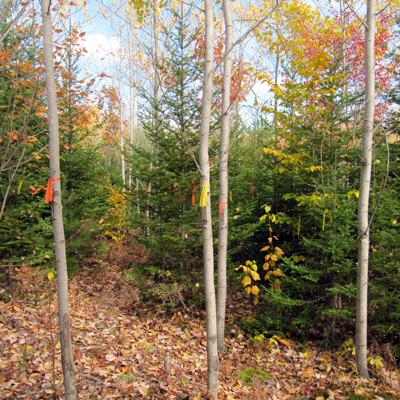Role of Silvicultural Intensity and Species Composition Objectives on the Growth and Dynamics Northeastern Forest Stands

Early successional forest stands in Maine (white birch, poplar, red maple, white spruce) are often a mixture of desirable and undesirable conifer and hardwood species. Stands are rarely managed, resulting in forest productivity decline. NSRC researchers examined effects of silvicultural intensity (thinning, thinning + enrichment planting, plantations) and species composition (conifer, mixedwood, hardwood) on growth dynamics of early successional Acadian stands in Maine. Researchers used new growth and yield computer models for juvenile trees to predict future biomass yields across treatments.
In high intensity hybrid poplar plantations, three years after planting, poplar growth began to diverge among the four clones, and by six years, the Populus nigra x P. maximowiczii (NM6) clone outperformed three P. deltoides x P. nigra clones (D51, DN10 and DN70) in pure stands and in mixtures with white spruce. In mixtures, white spruce biomass yield declined as poplar yield increased. White spruce monoculture yields were comparable to those reported in eastern Canada, while hybrid poplar yields were substantially lower than those reported on abandoned agricultural lands, likely due to harsher soil conditions in forest settings.
Seven years after treatment, biomass yields of the hardwood thinning and thinning+enrichment treatments were similar to the yield of an untreated control but with lower densities. In conifer release treatments, removal of hardwoods promoted conifer dominance, but yields of mixedwood treatments were greater than yields of conifer release treatments due to retention of thinned hardwoods. Findings show that early successional Acadian forest stands can be shifted in long-term developmental trajectories to meet a variety of landowner objectives using different silvicultural intensities.
